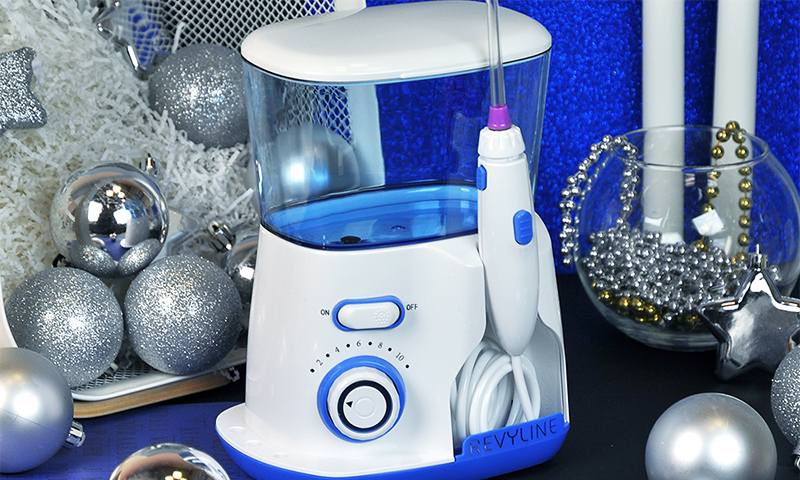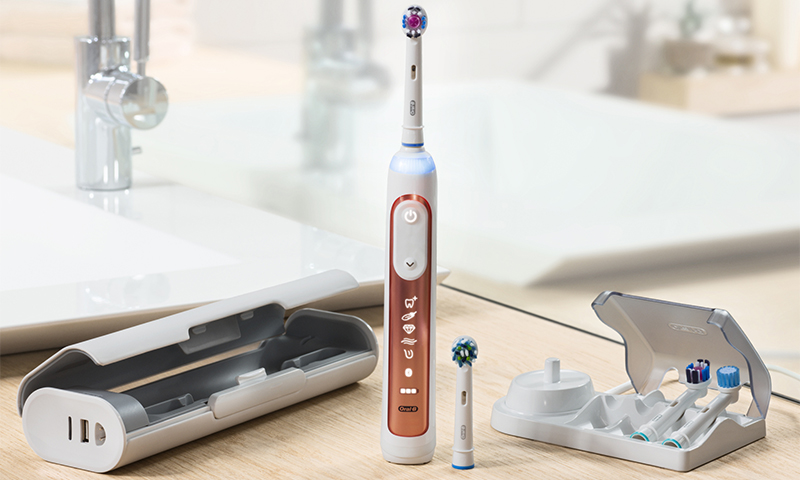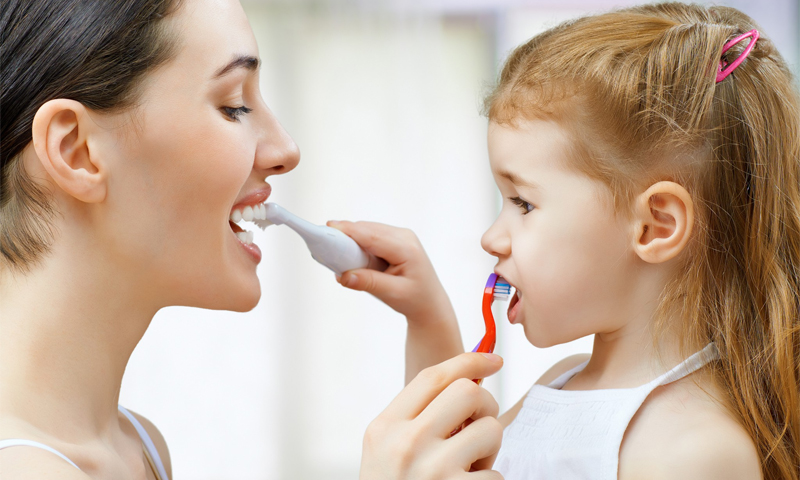The irrigator allows you to maintain the health and beauty of the oral cavity. The use of a toothbrush is not enough for proper dental hygiene. The device perfectly removes bacteria and plaque in the interdental space, behind the back molars and other hard-to-reach places. Also, the device prevents gum inflammation and eliminates unpleasant odor. Regular use at home can reduce the number of visits to the dentist, increase the service life of orthodontic appliances and restore healthy microflora in the oral cavity. How to choose an irrigator?

Content:
The best manufacturers of irrigators - which company to choose
One of the important parameters of the choice of irrigator is the manufacturer of the goods.
We have prepared a ranking of the best companies that have been producing high-quality irrigators for many years:
1. Waterpik
2. Sowash
3. JETPIK
4. AQUAJET
These brands are pioneers in the production of irrigators. Their products are in demand and competitive in many countries around the world, thanks to a wide range (for professional and home use), high-quality cleaning (several operating modes, power and pressure regulators) and an acceptable cost.
You can find out which models of these devices have gained the trust of dentists and ordinary users from our ranking best irrigators.
The principle of operation and device irrigators
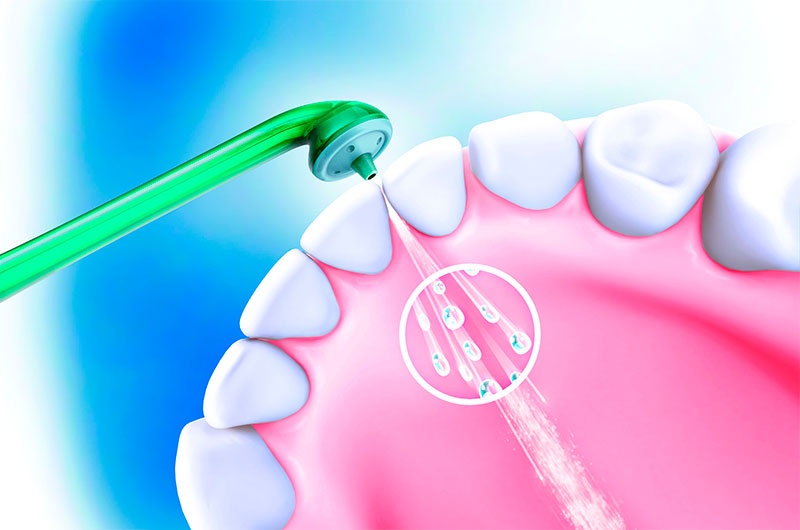
The irrigator is a device for maintaining oral hygiene. The device performs the functions of removing plaque and debris between the teeth, massage the dental gums, tongue and mucous membrane due to the directional pressure of the liquid.
Depending on the particular model, the jet may be pulsating, continuous, or contain microbubbles. As a flushing liquid, ordinary running water or special solutions with a preventive effect are used. Thanks to special nozzles, the jet reaches areas in the oral cavity that are not accessible when brushing with a conventional toothbrush or floss. And the head pressure adjustment allows the device to be used by both children and adults.
The irrigator is recommended to use in the presence of crowns, bridges, prosthetic teeth, braces, or other orthodontic structures.
Also, indications for use are:
- prevention of gum disease and teeth;
- elimination of unpleasant smell;
- cleaning inaccessible to the toothbrush in the mouth;
- reduction of increased bleeding gums.
The irrigator acts as an additional means of cleansing the oral cavity. The device should not be considered as an alternative to a toothbrush or thread, as Its main purpose is soft hygiene of hard-to-reach places, interdental spaces in the oral cavity and gum massage.
Using this device up to 3 times a week reduces the formation of bacterial plaque, increases the efficiency of oral hygiene by 50%, improves blood circulation in the gum tissues and the general condition of the teeth.
Types of irrigators
By design
Stationary
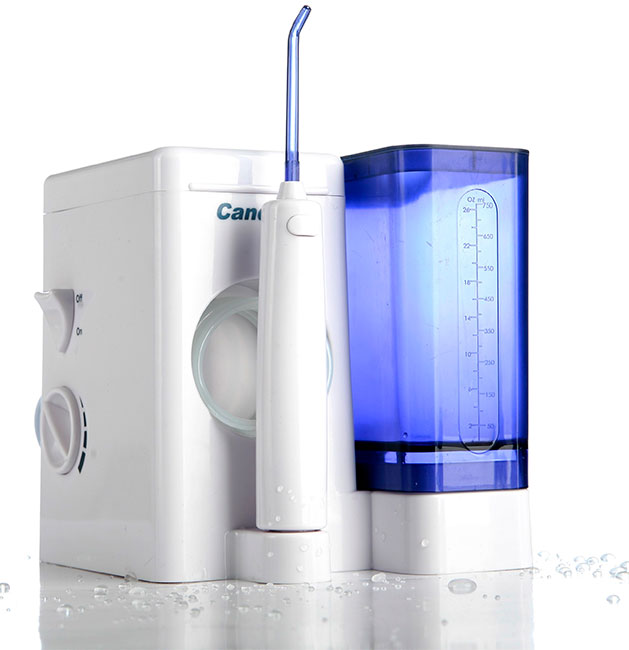
These irrigators are designed for indoor use (more often at home). Work from the power supply. The devices are equipped with a compressor, which injects pressure, under the action of which a water stream is formed. Head power adjustable. Irrigators are suitable for use by the whole family, as Included are a variety of nozzles.
Advantages:
- high power allows you to choose the optimal pressure jet;
- wide range of head adjustment;
- large volume of fluid reservoir;
- In many models there are many built-in nozzles;
- Intensive care for gums and teeth.
Disadvantages:
- increased vibration;
- massiveness, noise;
- work from the mains;
- high price.
Portable
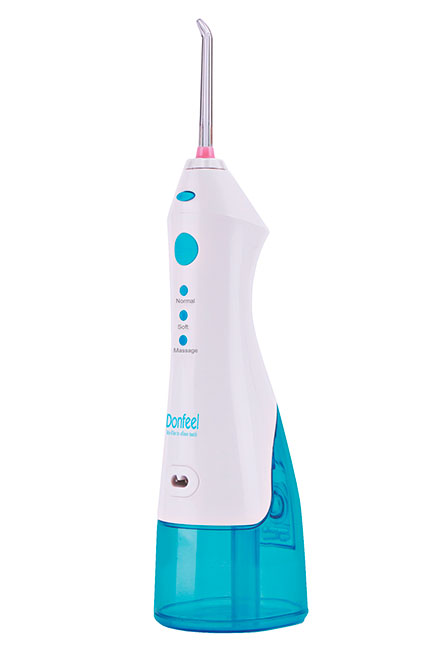
The devices operate from an integrated power source. They consist of a liquid container, a pump and a removable nozzle. Some models have a folding structure, so easily fit in a small handbag. Such irrigators are recommended for individual use on trips.
Advantages:
- small weight, mobility, ergonomics;
- great for travel, business trips;
- low noise.
Disadvantages:
- low current sources do not allow to develop the required jet pressure;
- the need for frequent battery replacement or battery charge;
- lightweight construction is easy to damage;
- a small supply of water or solution may not be enough to fully clean all parts of the oral cavity.
By cleaning technology
Pulsating jet
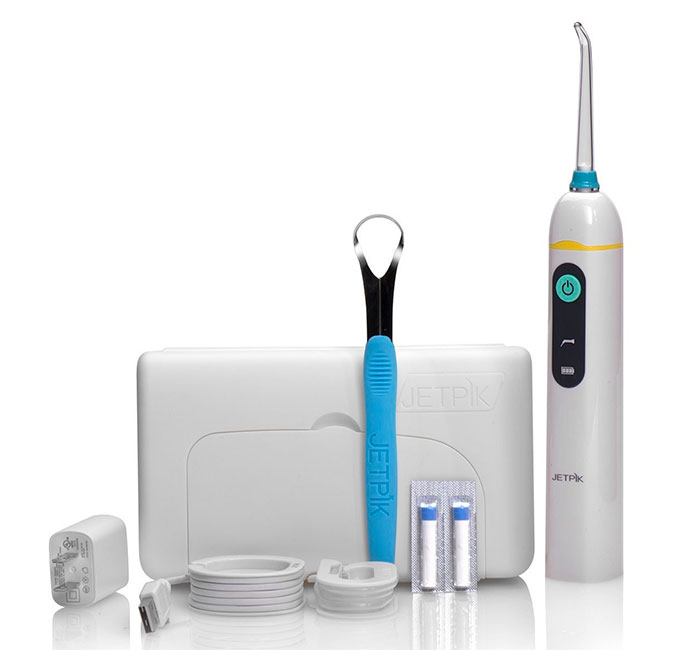
The device creates a thin stream with short pulsations (an average of 1200 micro pulses per 1 minute). Due to this, micro-hydraulic shocks are created, allowing to effectively eliminate bacterial plaque. This irrigator is recommended for persons at risk of developing periodontal gingivitis.
Advantages:
- short pulsations are almost invisible to the user;
- provides an effective massage of periodontal tissues, improves blood circulation;
- efficiently cleans plaque in the polar region, in the interdental spaces.
Disadvantages:
- it is necessary to change nozzles periodically;
- high price.
Microbubble technology
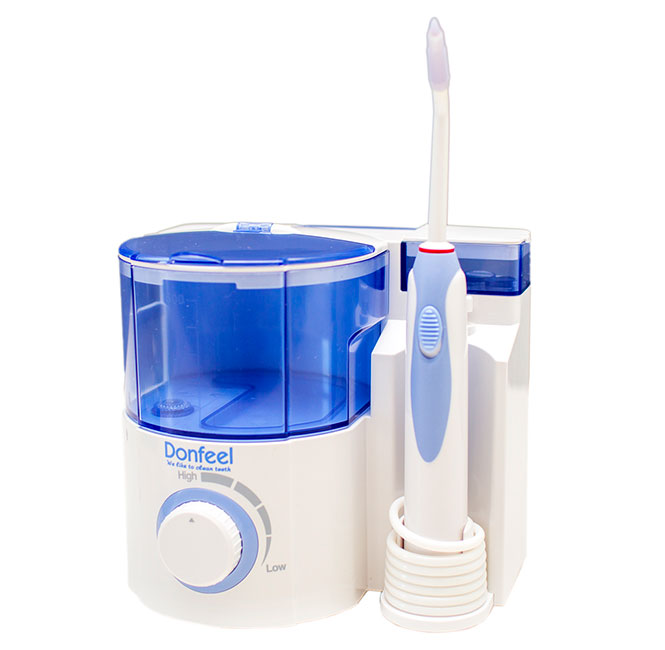
This technology is considered the most effective. The irrigator mixes air bubbles with a stream of water, which contributes to the qualitative removal of plaque and food debris, and the water is also saturated with oxygen, which has a bactericidal effect on the pathogenic flora. Typically, this irrigator has several modes of operation: standard and soft head pressure. The devices are also successfully used for washing the nose, oropharynx, for periodontitis, gingivitis, periodontal disease and as a prophylaxis of these diseases.
Advantages:
- proper use of nozzles helps to stop the disease, as well as strengthen the gum tissue;
- high-quality cleaning of gum pockets, interdental spaces;
- bactericidal effect.
Disadvantages:
- high price;
- after each use it is recommended to release the reservoir from the remaining liquid, otherwise the device may fail.
Monostruya
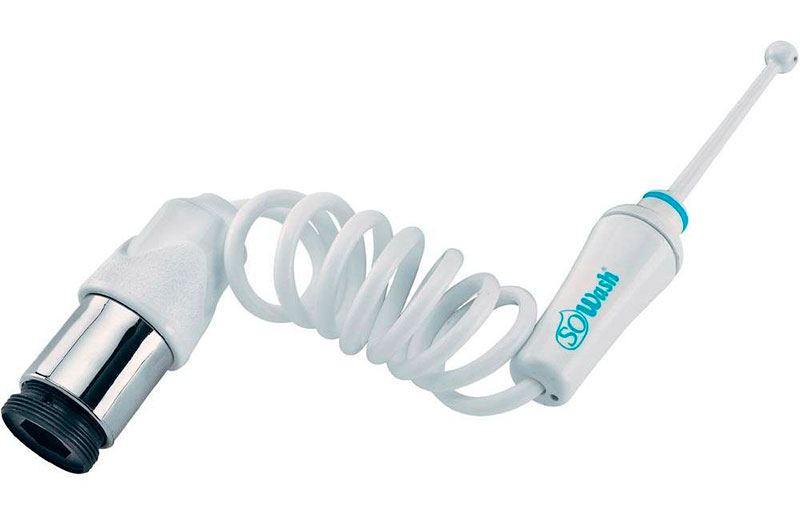
The device is connected to the water supply and delivers a continuous stream of water. The irrigator is an adapter for the crane, connected by a hose to the handle of the device. Because Such models do not allow the use of boiled or filtered water, some devices are equipped with a special capsule with an antibacterial liquid. This technology is suitable for the prevention of diseases of the gums and teeth.
Advantages:
- ease of use;
- affordable cost;
- work without power supply;
- The device reduces the likelihood of developing diseases of the teeth and gums.
Disadvantages:
- in terms of efficiency, irrigation plants with a monostuy are inferior to pulsating and microbubble technology;
- before each use it is necessary to screw the adapter onto the crane, which requires time and effort;
- Due to the unsatisfactory quality of tap water, the use of this type of irrigators is contraindicated.
Irrigator selection options

1. View of the irrigator
Before buying it is necessary to determine the type of irrigator. First, you should choose based on the conditions in which the device will be used. Secondly, it is necessary to decide on the cleaning technology, taking into account the advantages and disadvantages of each model.
2. Head pressure
Choosing an irrigator, you should pay attention to the presence of pressure adjustment. If the device will be used by children or people with bleeding gums, the irrigator should have a gentle pressure mode with a slight pressure.If the irrigator is necessary for deep intensive cleaning, then it should have a strong pressure.
3. Modes of operation
Most modern irrigators have different modes of operation, the most common are: floss, pulsation, micro massage, turbo flow (spiral and three-jet), spray.
4. Power
This parameter directly affects the pressure that is created in the tank. In stationary devices, the pressure varies between 600-800 kPa, in portable devices - 250-600 kPa.
5. Equipment
Basically, from 4 to 10 nozzles are attached to stationary models, and from 1 to 4 to portable ones. Some manufacturers include only standard nozzles for preventive care.
If a person has braces, a bridge and other structures, or there are any diseases of the teeth, then you should choose an irrigator, complete with periodontal, orthodontic tips.
There are also the following nozzles:
- for subgingival space;
- to clean the tongue;
- for washing the nasal sinuses.
6. Ripple frequency
This indicator can be from 900 to 3000 pulses per minute.
7. Continuous use time
Attention should be paid to this parameter if the choice is stopped on a portable irrigator. The usage time depends on the type and capacity of the battery. It is better to choose lithium-ion batteries, which charge enough for a long time.
8. Tank capacity
The capacity of a stationary irrigator can have a volume of from 600 to 1000 ml, stationary - 120-250 ml. The selection should be based on the number of family members who will use the device.
9. The possibility of warranty and service
Irrigators from different manufacturers may have similar characteristics. In this case, you should pay attention to the availability of warranty and service. Some models can not be repaired due to scarce parts, so it is very important that the manufacturer provides a guarantee and the possibility of post-warranty service in the event of a malfunction of the device.
Which irrigator to choose
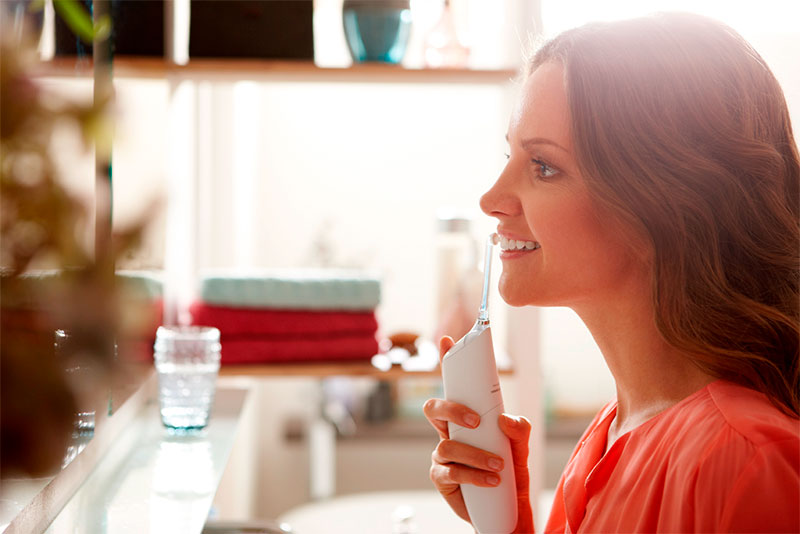
1. If the irrigator is necessary for use on trips, business trips or travels, then you should choose a portable type of irrigator.
2. If the device is necessary for home use, then you should choose a stationary irrigator.
3. If it is purchased for preventive purposes, it is better to choose a budget model with a basic set of nozzles. If the irrigator is needed for effective cleaning of orthodontic structures (bracket-system, bridge, etc.) or for diseases of the teeth, then you should choose a stationary device with an expanded configuration and various modes of operation.
4. A family consisting of several family members should be given preference for models with a large tank volume. If the irrigator will be used by one person, it is better to choose a small container.
5. If the choice is stopped on a portable model, then you should pay attention to the battery capacity. The higher it is, the longer the device will work on a single charge and the user will not often have to charge the irrigator battery.
6. If the device will be used by children or people with bleeding gums, the irrigator must have a head adjustment with which you can set a gentle mode of operation.
7. 1200 is the optimal number of pulsations per minute, so when choosing, you should focus on this number.
8. You should also choose irrigators with the possibility of warranty service, so the user will be able to seek professional help in the event of a device breakdown.
How much do irrigators

1. The cost of portable irrigators: 2000-5000 p.
2. The cost of stationary irrigators: 2700-16000 p.
3. The cost of irrigators with mono jet: 2300-4000 p.
It will be interesting to friends too

